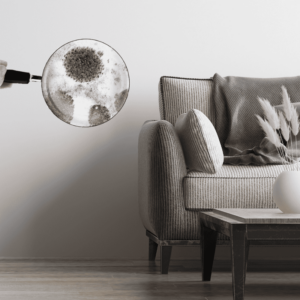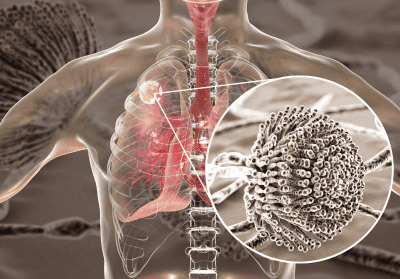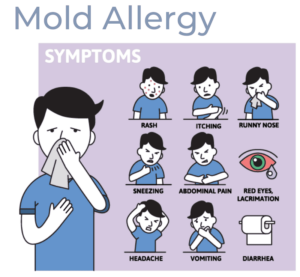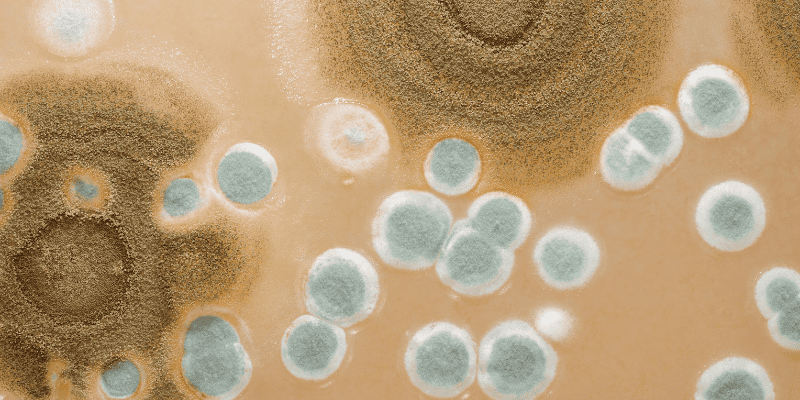Mold, a fungus that rapidly grows throughout an environment can be a real pain to deal with when it comes to your heightened allergies that flare at the slightest exposure to any type of mold allergen in the air. In a home that is growing mold, it may become unbearable for a person with allergies to be exposed to – as mold can produce very small, pesky allergens that will enter into the body and elicit a potentially severe bout of allergy-symptoms followed by an array of other possible health effects.
Mold spores are tiny, microscopic spores that are produced from mold in an effort to reproduce and grow on other surfaces within the environment. These tiny mold spores are very offending pollutants that travel in the air and can contribute to allergy-symptoms when exposure and/or inhalation takes place in the human body. A mold allergy is commonly associated with these produced spores that float in the air and are therefore the main driving force behind a mold allergy.
In this article we are going to discuss what will cause a mold spore allergy, the signs of a mold allergy, and how you can effectively reduce mold spores in the air.
Why Is Mold Bad?
 When we think about mold, we tend to associate mold as a ‘bad thing’ in our environment that can have potentially hazardous effects on the health of those exposed. Although this can be true in many instances, mold actually contains and contributes to many benefits in the environment. Mold is actually capable of breaking down dead substances and depositing them back into the ecosystem – this will allow for plants to be broken down into soil. Another capability of mold is as an antibiotic such as penicillin and many others – this is a surprising fact that many people are probably unaware of when it comes to mold.
When we think about mold, we tend to associate mold as a ‘bad thing’ in our environment that can have potentially hazardous effects on the health of those exposed. Although this can be true in many instances, mold actually contains and contributes to many benefits in the environment. Mold is actually capable of breaking down dead substances and depositing them back into the ecosystem – this will allow for plants to be broken down into soil. Another capability of mold is as an antibiotic such as penicillin and many others – this is a surprising fact that many people are probably unaware of when it comes to mold.
Although mold has many different benefits, when it is found growing inside of your home it can produce potentially hazardous effects that can be dangerous to human health – especially when you are exposed to certain species of mold. Can mold make you sick? Yes it can. There are a wide variety of mold species that can grow both in outdoor and indoor environments – from Cladosporium, Alternaria, Aspergillus, Penicillium, and Stachybotrys Chartarum –black mold vs mold. These different types of mold species and mold identification can each produce and elicit different health effects when exposure occurs in the environment -and when it comes to some of these species of mold, they can be really dangerous to your health.
Mold Spores in the Air
As mold develops inside of a home it will do so very rapidly and inconspicuously, with the first signs of this mold growth being a noticeable discoloration on the surfaces of your home (i.e. walls, ceiling, and floors). Although this is the first sign that you will be visible to with mold growth, there is a sign of mold that will strike way before a noticeable discoloration appears on your home’s surfaces, and that is allergy-like symptoms that will persist when you are present in an environment where mold growth is ensuing.
Molds produce allergens into the air that can trigger a bout of health symptoms particularly in those who are prone to allergies and asthma. When mold spreads within an enclosed space it does so by releasing mold spores into the air that will attach to different surfaces in this environment. Mold spores are tiny pollutants that are produced by molds for the exact purpose of reproduction that will float in the air due to their light weight. When mold spores float in the air they can be easily inhaled into the human body and trigger an allergic reaction in sensitive individuals. An allergic reaction to mold spores is a fairly common allergy that many people experience – either immediately or delayed but it can trigger both asthmatic attacks and allergy symptoms.
Symptoms of Breathing Mold
 A mold allergy works similarly, if not identically to any other allergy that occurs in the human body. An allergy is triggered by the immune system which will identify an allergen that has entered the body as a foreign invader and will begin to fight off this invader to protect the body – this will spark an allergic reaction with symptoms that will shortly follow. A mold allergy will produce a cough, make your eyes itchy, and can cause other symptoms that can be irritating. The major signs of a mold allergy will include the following symptoms:
A mold allergy works similarly, if not identically to any other allergy that occurs in the human body. An allergy is triggered by the immune system which will identify an allergen that has entered the body as a foreign invader and will begin to fight off this invader to protect the body – this will spark an allergic reaction with symptoms that will shortly follow. A mold allergy will produce a cough, make your eyes itchy, and can cause other symptoms that can be irritating. The major signs of a mold allergy will include the following symptoms:
- Sneezing
- Runny or stuffy nose
- Cough and postnasal drip
- Itchy eyes, nose, and throat
- Watery eyes
- Scaly, dry skin
The severity of a mold allergy will depend on the person, some may experience mild symptoms while others can experience severe symptoms. If you experience these symptoms year-round this may be a great indicator that a mold allergy is at play.
Mold and Asthma Aggravation
Did you know that more than 26 million Americans suffer from asthma? This means a large population of the country would be susceptible to asthmatic reactions in the presence of mold and mold spores in the air of their indoor environment. Due to the small size of mold spores, when they travel into the air and enter into the human body through inhalation it will reach the lungs and trigger a potential asthmatic episode for those who suffer from asthma.
During an asthmatic episode the lungs will begin to become irritated and airway restriction will occur – this will produce more mucus and lead to the lungs becoming red and swollen. Ultimately, mold and asthma aggravation will go hand in hand as it will result in an array of asthmatic symptoms in the human body.
Signs of Mold Allergy
 A mold allergy will present some tell-tale signs of its existence inside of an individual – some that may be hard to identify right away. Just like any other allergy, a person will experience the usual symptoms that are associated with allergies such as coughing, sneezing, itchy eyes, fatigue, and even throat irritation. This reaction is caused by allergens that are released into the air from mold, such as mold spores that can easily become inhaled into the body and trigger the start of allergy symptoms.
A mold allergy will present some tell-tale signs of its existence inside of an individual – some that may be hard to identify right away. Just like any other allergy, a person will experience the usual symptoms that are associated with allergies such as coughing, sneezing, itchy eyes, fatigue, and even throat irritation. This reaction is caused by allergens that are released into the air from mold, such as mold spores that can easily become inhaled into the body and trigger the start of allergy symptoms.
Allergy symptoms from a mold allergy can quickly transition into an asthmatic attack and can further develop into something far worse such as an upper respiratory infection and trouble breathing. When your health starts to steadily react when inside your home this will be the main sign of a mold allergy at work – and this will lead to the need to learn how to identify mold and properly remove it from the environment.
How Long Do Mold Symptoms Last
Mold sickness or mold allergies is a persisting form of illness that can occur for a long duration of time, particularly when mold exposure is present in your environment. Mold is a very sneaky fungus that can grow quickly and often times unknowingly inside your home – all the while your mold symptoms will continue to take place inside your body, with allergy symptoms in full force.
Generally, however, the duration of your mold symptoms will last as long as you are exposed to mold and have no treatment for this allergy to prevent symptoms.
How to Reduce Mold Spores in the Air
The process of mold forming inside of your home can elicit and create potential toxins into the air that can be hazardous to the environment and the health of those individuals exposed to this environment. Mold produces allergens and other toxins into the air and when exposure into the body occurs it can significantly impact the health of that individual. The reproductive seeds produced from mold called mold spores are of big concern when dealing with mold growth in your home – these microscopic spores can travel into the air and easily become inhaled/ingested into the lungs. The best way to combat these potentially hazardous pollutants from the air is through the use of a mold spore air purifier that provides the capability to remove these small spores from the air.
The EnviroKlenz UV Mobile System is an effective air purification device that utilizes a two-stage filtration along with UV-C lights to provide an efficient kill of microorganisms including mold spores, bacteria, and viruses. The first stage filtration within the EnviroKlenz UV Mobile System is a VOC Air Filter that contains the EnviroKlenz patented earth mineral technology for VOC, chemical, and noxious odor elimination. The second stage filtration is a hospital-grade HEPA filter that is able to filter out particulate matter larger than 0.3 microns in size with a 99.97 percent efficiency. What makes this air purifier ideal for mold and mold spore removal is the UV-C lights that shine above the HEPA filter that allows it to effectively kill the mold spores that are collected on top of the HEPA filter.
UV Mobile Air System
✓ Patented earth mineral technology works to attack VOCs and break them down on a compound level
✓ No chemicals or masking agents
✓ Will not release any chemicals back into your environment
✓ UVC lamps are continuously shining on the collected organisms with high effeciency of kill and destruction
EnviroKlenz® Medical Disclaimer:
“Any information that is provided on this website is not for the use by any commercial or personal entity without expressed written consent of the blog author. The material and statements illustrated within this blog are not intended to diagnose, treat, cure, or prevent any diseases or medical conditions. Nor does the author in any way guarantee or validate the validity, totality, or efficacy of any claims and will therefore not be held responsible for the content of any claims. Always consult your medical physician for any specific medical advice or recommendations.”








